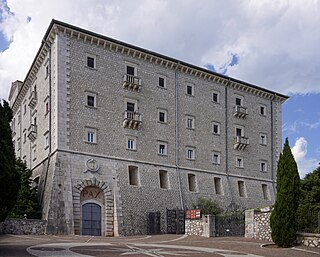
Monte Cassino is a rocky hill about 130 kilometres (80 mi) southeast of Rome, in the Latin Valley, Italy, 2 kilometres west of Cassino and at an elevation of 520 m (1,710 ft). Site of the Roman town of Casinum, it is widely known for its abbey, the first house of the Benedictine Order, having been established by Benedict of Nursia himself around 529. It was for the community of Monte Cassino that the Rule of Saint Benedict was composed.

Pope Liberius was the bishop of Rome from 17 May 352 until his death. According to the Catalogus Liberianus, he was consecrated on 22 May as the successor to Julius I. He is not mentioned as a saint in the Roman Martyrology. That makes him the earliest pontiff not to be venerated as a saint in the Catholic Church and, along with Anastasius II, one of only two popes to be omitted from Catholic sainthood in the first 500 years of church history.

Germanus of Auxerre was a western Roman clergyman who was bishop of Autissiodorum in Late Antique Gaul. He abandoned a career as a high-ranking government official to devote his formidable energy towards the promotion of the church and the protection of his "flock" in dangerous times, personally confronting, for instance, the barbarian king "Goar". In Britain he is best remembered for his journey to combat Pelagianism in or around 429 AD, and the records of this visit provide valuable information on the state of post-Roman British society. He also played an important part in the establishment and promotion of the Cult of Saint Alban. The saint was said to have revealed the story of his martyrdom to Germanus in a dream or holy vision, and Germanus ordered this to be written down for public display. Germanus is venerated as a saint in both the Roman Catholic and Orthodox churches, which commemorate him on 31 July.

Eusebius of Vercelli was a bishop from Sardinia and is counted a saint. Along with Athanasius, he affirmed the divinity of Jesus against Arianism.

Bernardo Tolomei was an Italian Catholic priest and the founder of the Congregation of the Blessed Virgin of Monte Oliveto. In the Roman Martyrology he is commemorated on August 20, but in the Benedictine calendar his optional memorial is celebrated on the previous day.
The Council of Ariminum, also known as the Council of Rimini, was an early Christian church synod in Ariminum, modern-day Rimini, in 359. Called by Roman Emperor Constantius II to resolve the Arian controversy, the Council of Ariminum for western bishops paralleled the Council of Seleucia for eastern bishops.
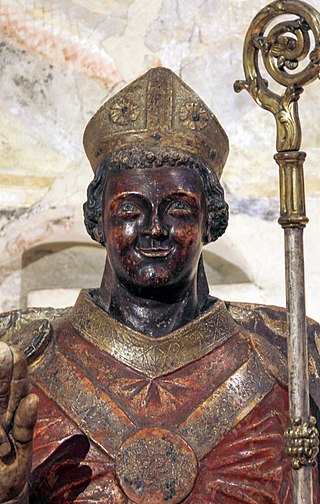
Zeno of Verona was an Afro-Italian Christian figure believed to have either served as Bishop of Verona or died as a martyr. He is venerated as a saint in the Catholic Church and the Orthodox Church.

Constantius of Perugia is one of the patron saints of Perugia, Italy.
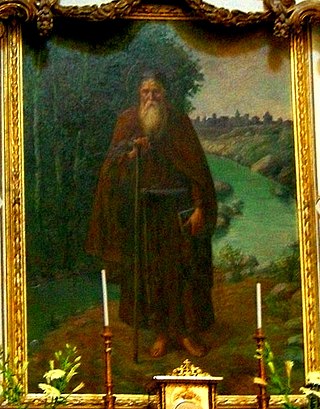
Conrad Confalonieri of Piacenza, TOSF, was an Italian hermit of the Third Order of St. Francis, who is venerated as a saint.

The Archdiocese of Capua is a Latin diocese of the Catholic Church in Capua, in Campania, Italy, but its archbishop no longer holds metropolitan rank and has no ecclesiastical province. Since 1979, it is a suffragan of the Archdiocese of Napoli, i.e. no longer has its own ecclesiastical province nor metropolitan status.
Victor of Capua was a sixth-century bishop of Capua in Italy.
Saint Vitalian(us) of Capua was a 7th-century bishop of that city.

Chiaffredo is venerated as the patron saint of Saluzzo, Italy. Tradition considers him a member of the Theban Legion, but instead of being martyred with this legion at Agaunum, he escaped to Piedmont and was martyred there.

Saint Nonnosus, also Nonosius, was a prior at the San Silvestre monastery on Monte Soratte north of Rome and later a monk at Suppentonia, near Civita Castellana. He was a contemporary of Saint Benedict of Nursia. Alban Butler has written that “so little information has survived about Nonnosus that he is not especially interesting in himself.” His name does not appear in any ancient martyrology.

Saint Magnus of Anagni, also known as Magnus of Trani or Magnus of Fabrateria Vetus, is venerated as the patron saint of Anagni.

Constantius is venerated as a member of the legendary Theban Legion. Similar to the cults of Chiaffredo at Crissolo, Bessus at Val Soana, Tegulus at Ivrea, Magnus at Castelmagno, and Dalmatius at Borgo San Dalmazzo, the cult of Constantius was linked with that of the Theban Legion to lend antiquity to a local saint about whom nothing was really known.

Aquino is a town and comune in the province of Frosinone, in the Lazio region of Italy, 12 kilometres (7 mi) northwest of Cassino.
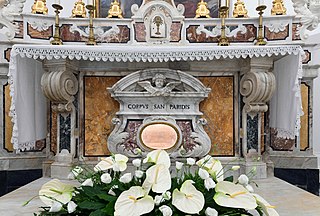
Saint Paris or Paris of Teano was ordained Bishop of Teano by Pope Sylvester I. His feast day is August 5.
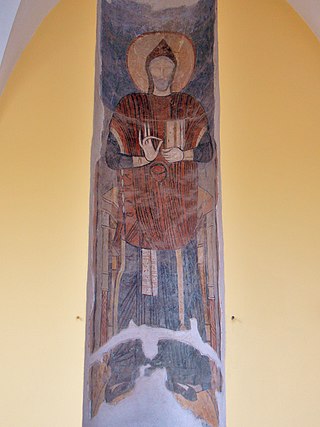
Constantius was a Bishop of the Catholic Church who, after many years wandering, became the patron saint of Capri.

Aquino Cathedral is a Roman Catholic cathedral in Aquino, Lazio, Italy. It is dedicated to Saints Constantius of Aquino and Thomas Aquinas.















